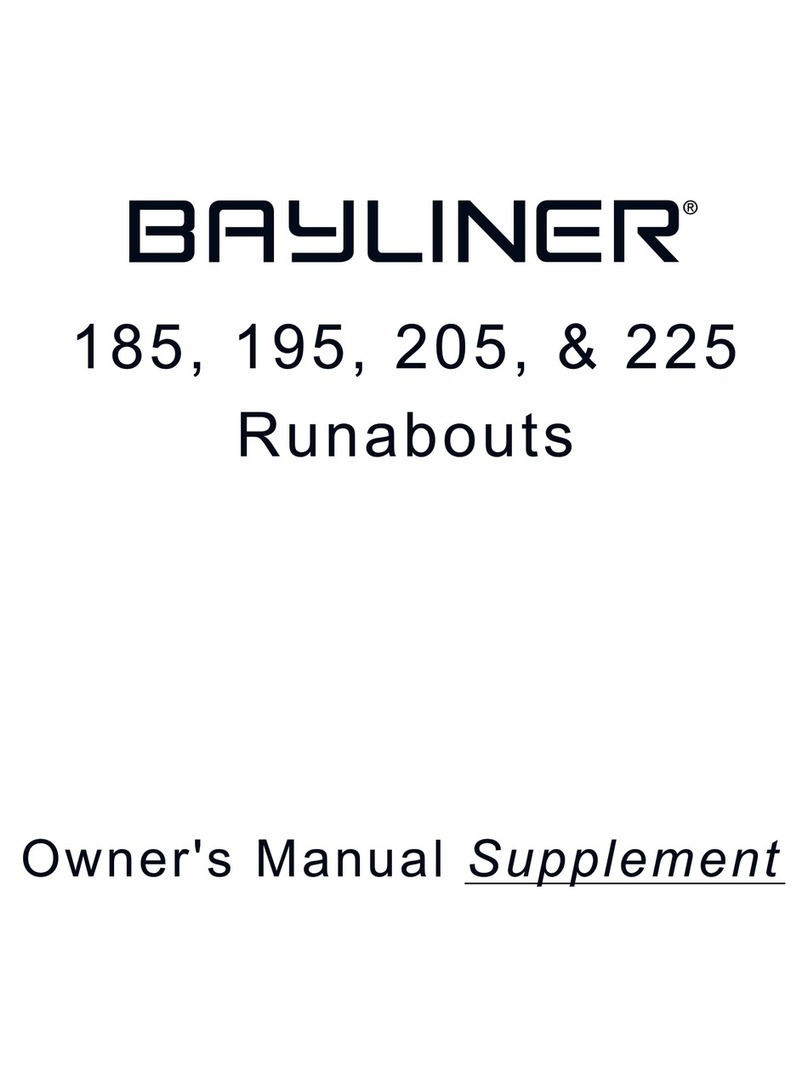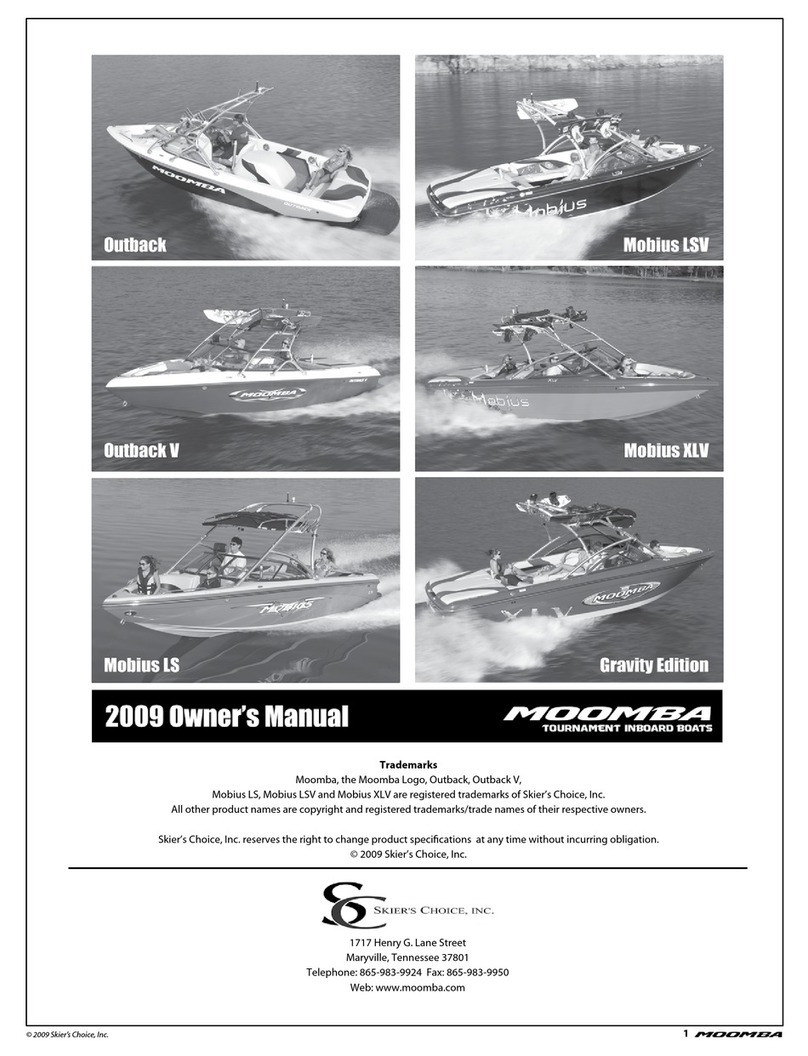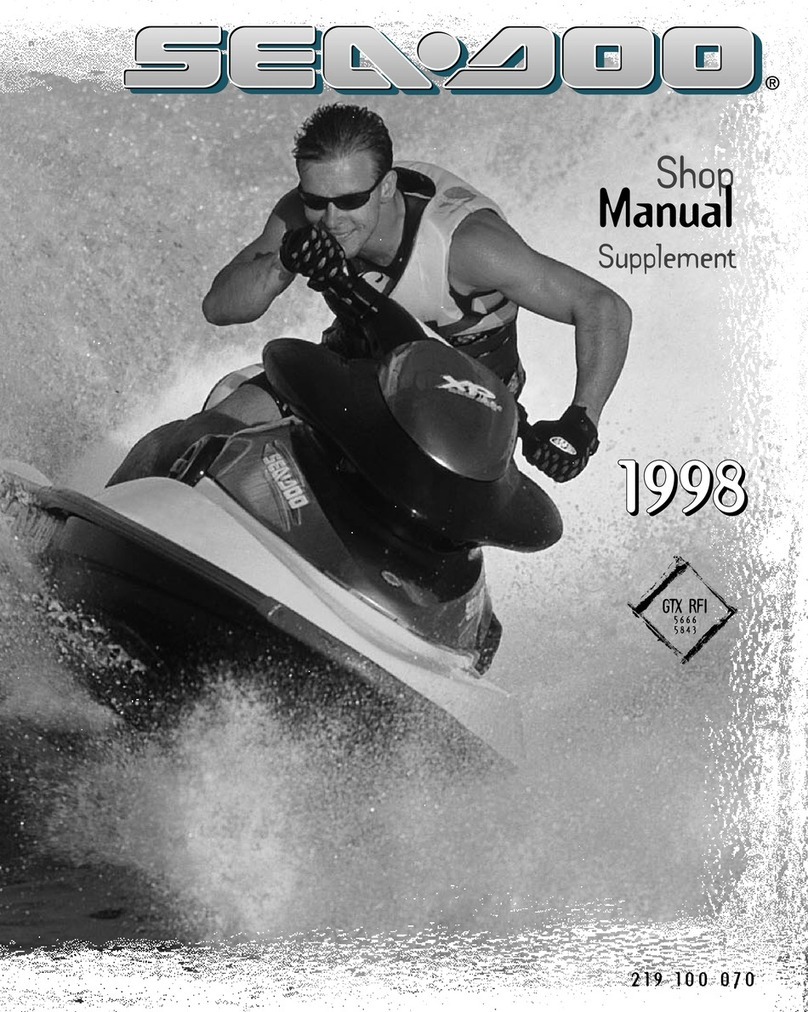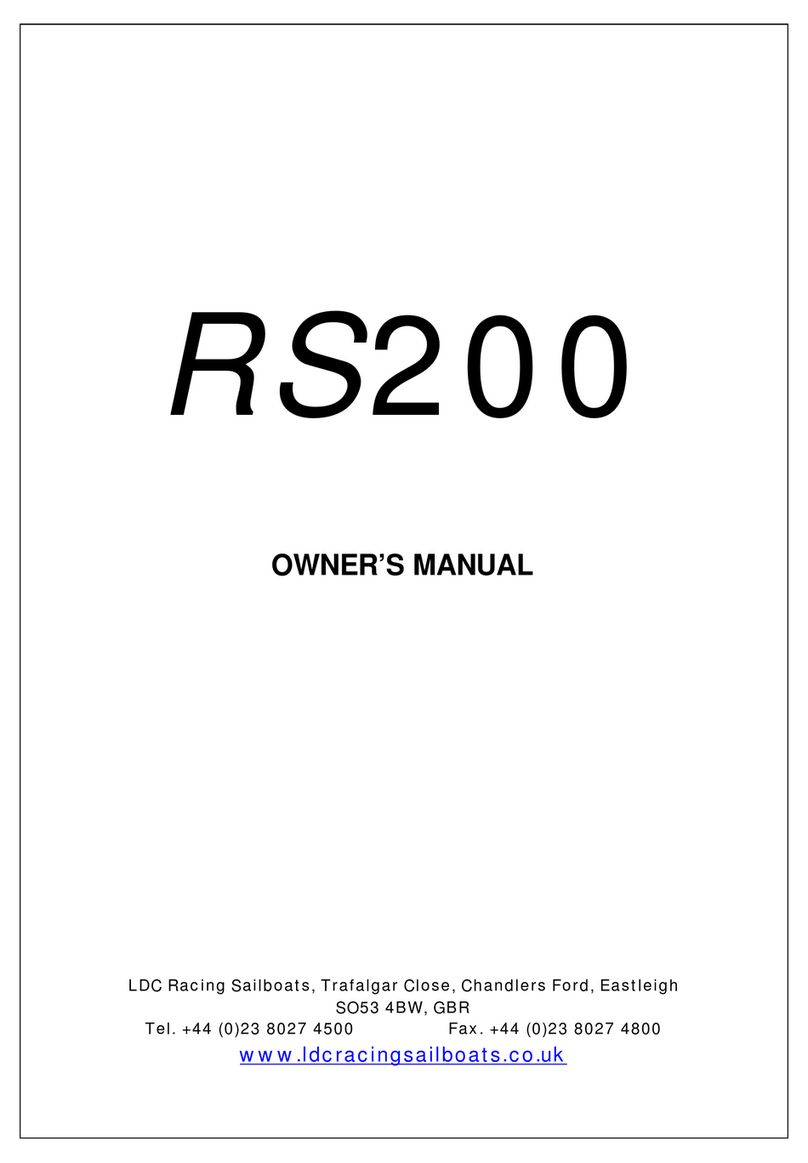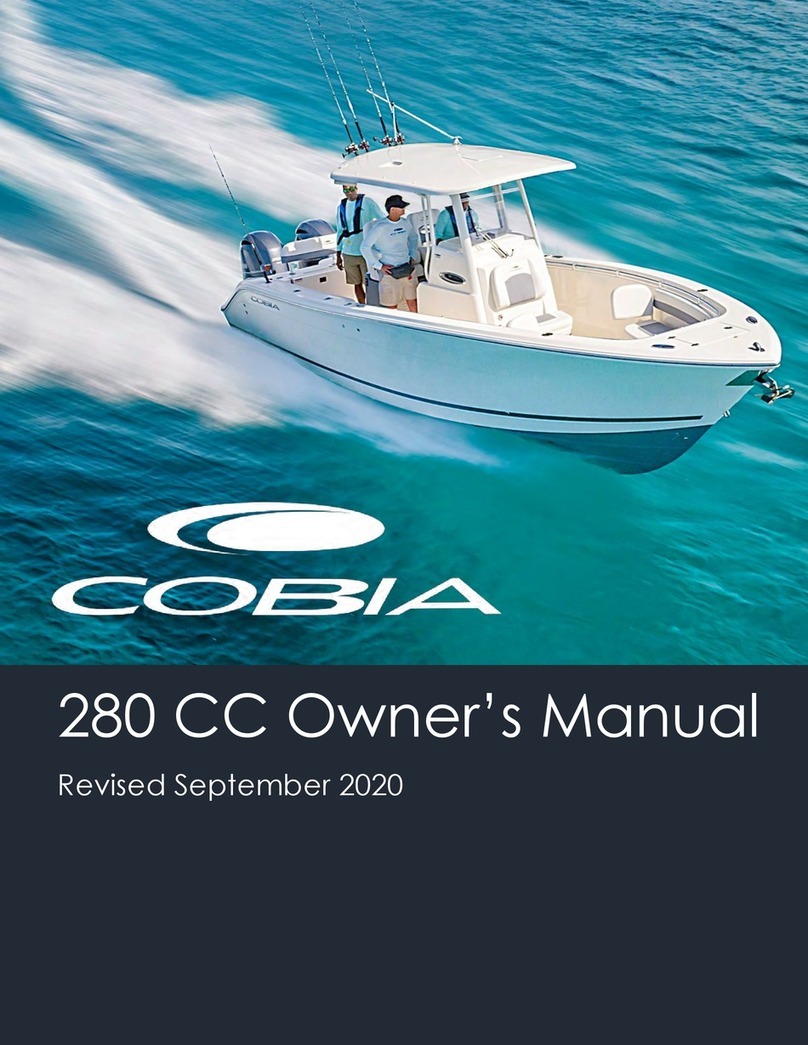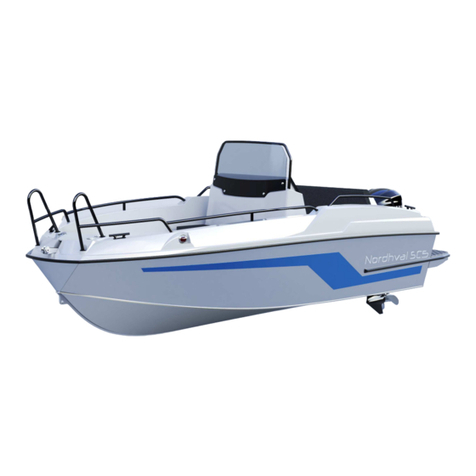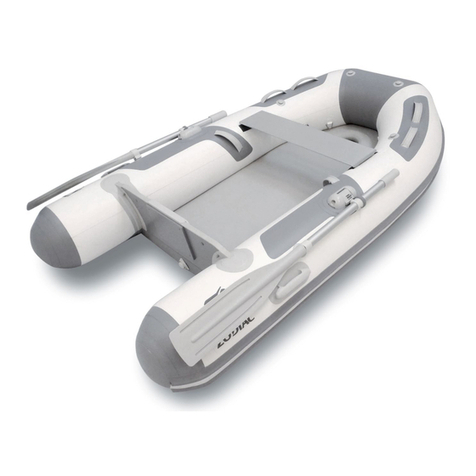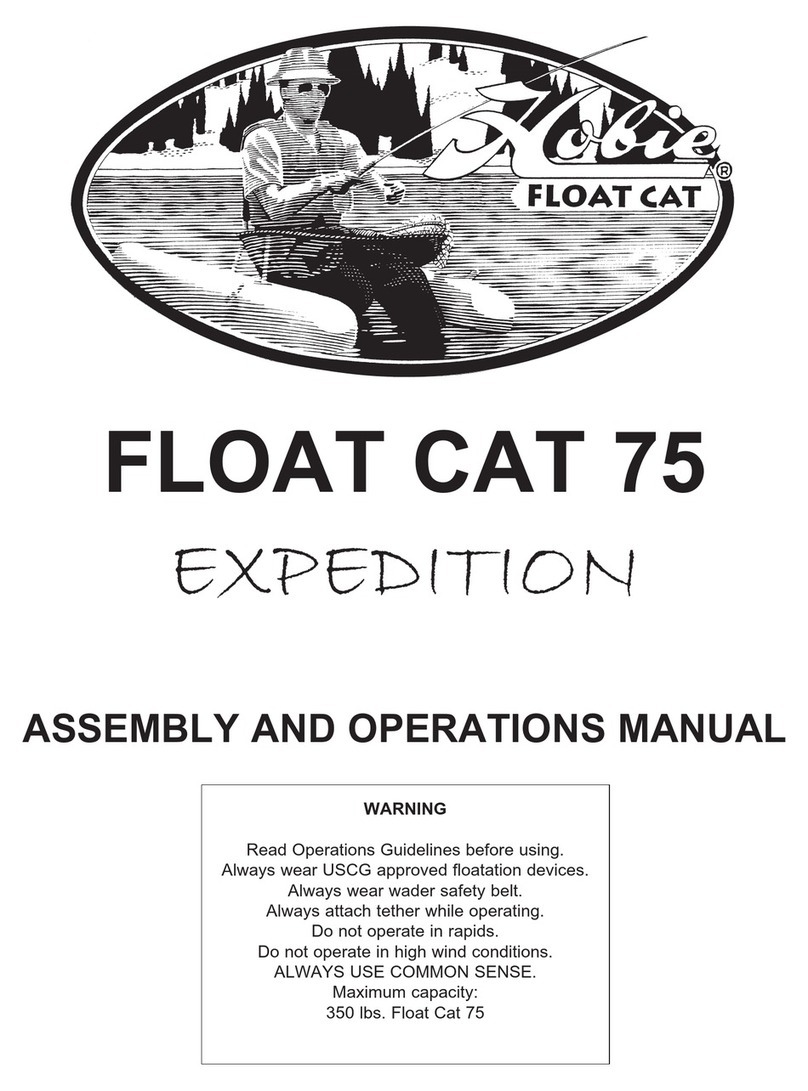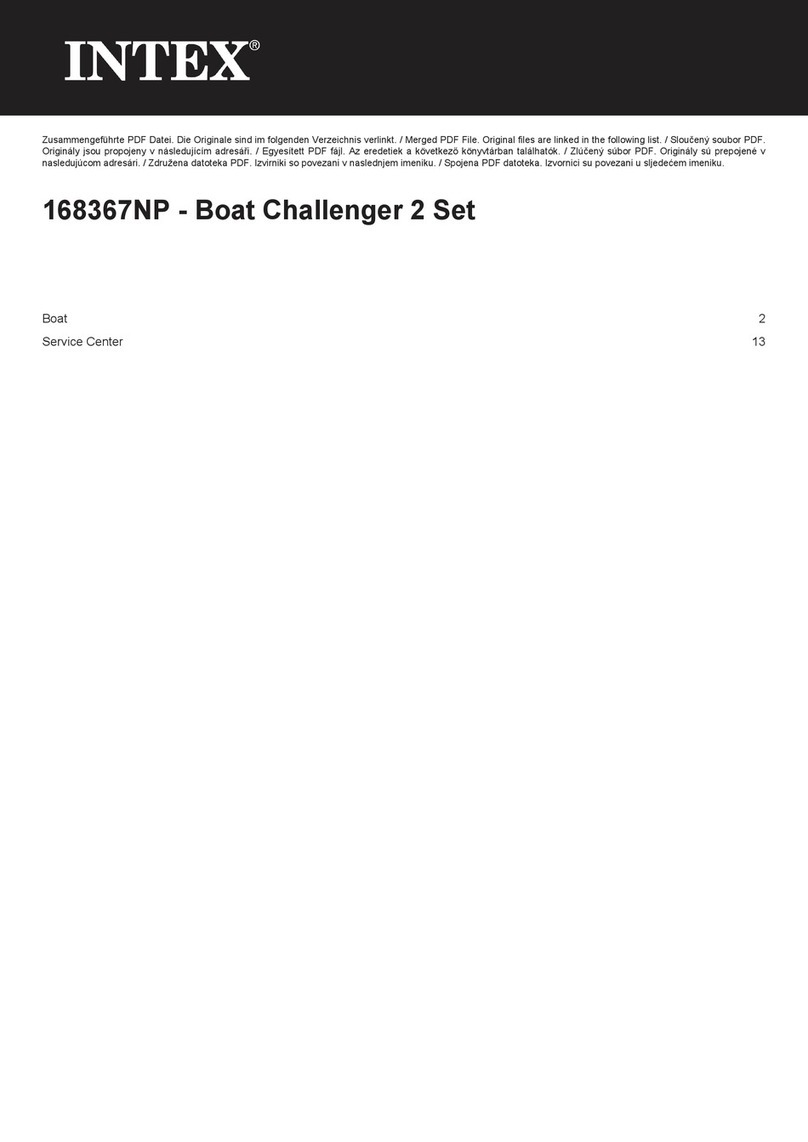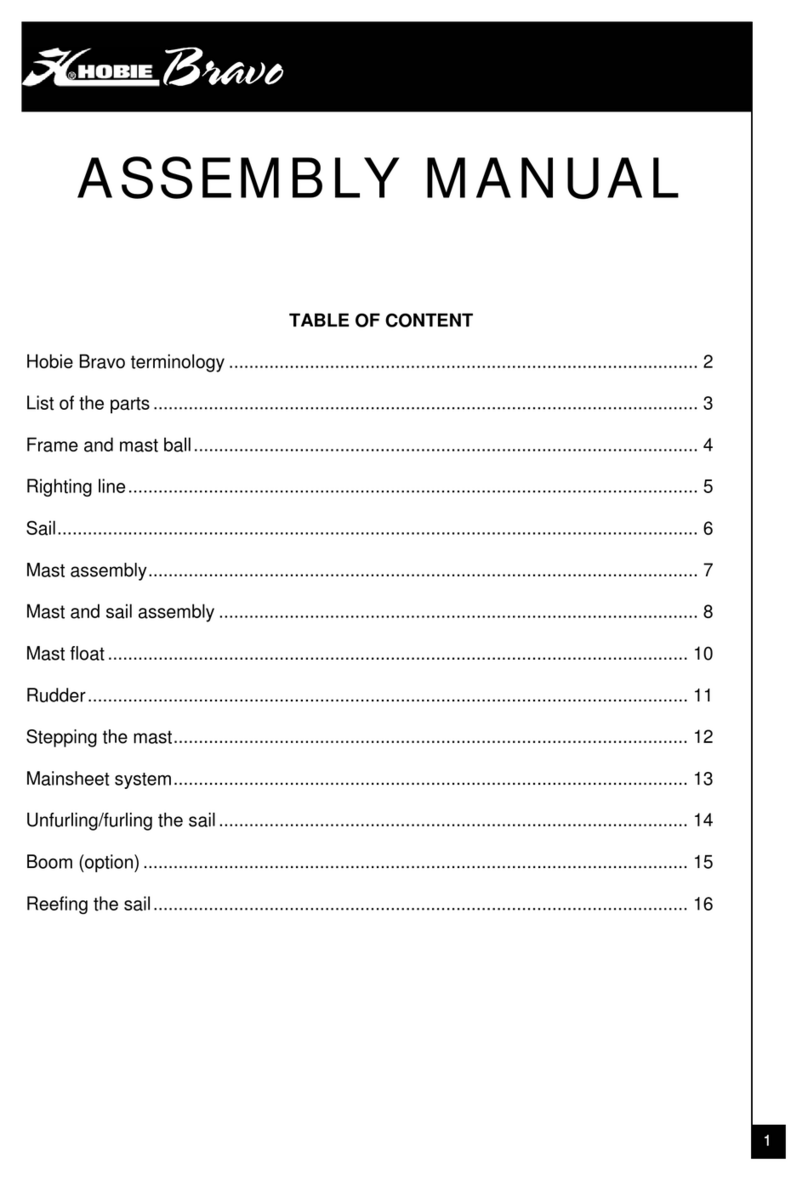Fiskars BUSTER XXL User guide

BUSTER
www.buster.fi
OMISTAJAN KÄSIKIRJA
ÄGARENS HANDBOK
BOOTSEIGNER-HANDBUCH
OWNER’S HANDBOOK
MANUEL DU PROPRIÉTAIRE
HANDLEIDING voor de EIGENAAR
НАСТОЛЬНАЯ КНИГА ВЛАДЕЛЬЦА
OMANIKU KÄSIRAAMAT
FI
SE
DE
EN
FR
NL
RU
ET
R
XXL
XXL

1
ENGLISH
OWNER’S HANDBOOK
Buster XXL
Inhan Tehtaat Oy Ab
Saarikyläntie 21, 63700 Ähtäri
Finland
Tel: +358 6 5355 111
Your Buster dealer:
Versio 1-2008

2
ENGLISH
PREFACE
Dear owner of the Finnish Buster boat! We thank you for choos-
ing Buster and hope you have many enjoyable experiences on
board.
The purpose of this handbook is to help you use your boat safely
and with peace of mind. The manual includes details of the boat
itself, the equipment and systems installed in it as well as infor-
mation related to operating and maintaining the boat. We urge
you to read this manual carefully and familiarise yourself with the
boat before starting to use it.
Naturally, the owner’s manual is not a primary source of seaman-
ship skills or boating safety. If Buster is your first boat or you have
changed to a type of boat that you are not yet familiar with, for the
sake of your comfort and safety, make sure that you acquire han-
dling and operating experience before you take on the responsi-
bility of command. The seller of the boat, a boat club or national
motorboat and yachting associations will be happy to provide you
with information about local boating schools or recommend com-
petent teachers.
Make sure that the prevailing wind and sea conditions correspond
to the design category of your boat and that you and your crew
are capable of handling it under such circumstances. The wind
conditions and sea swells corresponding to design category C
cover situations from a gale to heavy winds with an exceptional
risk of high waves and gusts. In such dangerous conditions, only
a competent and fit crew can satisfactorily operate a well-main-
tained boat.
This owner’s handbook is not a detailed guide to maintenance
and fault diagnosis. If a problem occurs, contact your nearest
Buster dealer. If there is a need for repairs, use only enterprises

3
ENGLISH
recommended by the Buster dealership. Alterations that affect
the safety characteristics of the boat can be carried out only on
the written approval of the manufacturer. The manufacturer of the
boat cannot be held responsible for changes it has not approved.
In some countries, driving a boat requires a license or the author-
ity to drive. Country-specific regulations may also be in force.
Always maintain your boat in good condition and bear in mind
the consequences of wear resulting from ageing, rough treatment
and improper use. Any boat, no matter how strong, can be signifi-
cantly damaged by improper use. Inappropriate boating habits do
not accord with safe seamanship. Always adapt the speed and
course of your boat in relation to the conditions at sea.
If your boat is equipped with a life raft, carefully read the oper-
ating instructions. The boat should have appropriate on-board
safety equipment (life jackets, safety harnesses etc.) that cor-
responds to the boat type and the weather conditions etc. In
some countries such equipment is mandatory. The crew must be
familiar with the operation of all safety equipment and emergency
manoeuvres (rescuing a man overboard, towing etc.). Rescue
exercises are regularly organised by sailing schools and clubs.
All persons on board must use an appropriate flotation aid (e.g.
lifejacket/life vest) when on deck. Note that in some countries
the law demands that flotation aids be used at all times when on
board.
STORE THIS HANDBOOK IN A SAFE PLACE AND HAND IT
OVER TO THE NEXT OWNER WHEN YOU RELINQUISH THE
BOAT.

4
ENGLISH
Contents
1 General.............................................................................................. l.8
2 Definitions...........................................................................................8
3 Warranty..............................................................................................9
4 Before launching .................................................................................9
4.1 Registration ................................................................................9
4.2 Insurance ...................................................................................9
4.3 Training ....................................................................................10
5 Boat characteristics and operation....................................................10
5.1 General ....................................................................................10
5.2 Basic information of the boat....................................................10
5.3 Recommended maximum number of people on board............12
5.4 Loading ....................................................................................14
5.4 Engine and propeller................................................................14
5.6 Preventing water getting on board and stability .......................15
5.6.1 Hull and deck opening...............................................15
5.6.2 Bilge pumps and drainage ........................................17
5.6.3 Stability and buoyancy ..............................................18
5.7 Prevention of fire or explosion..................................................18
5.7.1 Engines and fuel systems .........................................18
5.7.2 Fire extinguishing and fire prevention .......................20
5.8 Electrical system ......................................................................22
5.9 Control characteristics..............................................................26
5.9.1 Driving at high speeds...............................................26
5.9.2 Dead-man’s grip........................................................28
5.9.3 Visibility from the steering position............................28
5.10 Good seamanship – other recommendations and instructions.29
5.10.1 How to avoid falling overboard and how to get back
on board ....................................................................29
5.10.2 Securing loose equipment.........................................29
5.10.3 Respect for the environment .....................................29
5.10.4 Anchoring, mooring and towing.................................31
5.10.5 Trailer towing.............................................................33
5.10.6 Navigation .................................................................34
6 Service, repairs and winter storage...................................................35
7 Accessories.......................................................................................35
7.1 General. ...................................................................................35
7.2 Installing accessories ...............................................................36
7.2.1 Heater .......................................................................36
7.2.2 Refrigerator ...............................................................36
7.2.3 Radio/CD player........................................................36

5
ENGLISH
BOAT MODEL:
SERIAL NUMBER OF THE HULL - CIN:
MAKE AND MODEL OF THE ENGINE
SERIAL NUMBER OF THE ENGINE:
I Owner
First name:
Surname:
Residence:
Year of purchase:
II Owner
First name:
Surname:
Residence:
Year of purchase:
III Owner
First name:
Surname:
Residence:
Year of purchase:
IV Owner
First name:
Surname:
Residence:
Year of purchase:
Please inform us the above changes in ownership via Buster web page:
www.buster.fi/Contact_us.846.0.html.
This helps us and you in case of guarantee to find right contact information
from our guarantee register.

6
ENGLISH
BEFORE DEPARTURE…
Read this Owner’s Handbook thoroughly.
Always check the following before departure:
• Prevailing weather conditions and the weather forecast
Assess the wind conditions, the state of the sea and visibility. Is
your boat’s design class, size and on-board equipment as well
as the skills of the helmsman and crew sufficient for the water-
ways you intend to use?
• Load capacity
Do not overload the boat. Distribute the load properly. Do not
position heavy objects too high, so as to diminish the stability of
the boat.
• Passengers
Make sure there are life vests for all persons on board. Before
departure, agree on the duties each person is responsible for
during the trip.
• Fuel
Check that there is enough fuel on board, including enough re-
serve for bad weather etc. The amount of fuel on board should
exceed the necessary amount at least by 20% in case of un-
foreseen circumstances.
• Engine and equipment
Check that the steering, electrical devices and the battery func-
tion properly and are in good condition. Carry out the required
daily engine inspection procedures in accordance with the en-
gine manufacturer’s instruction manual. Check the seaworthi-
ness of the boat, i.e. no fuel- or water leaks, adequate safety
equipment on board etc. Check that the level of bilge water is
at minimum.

7
ENGLISH
• Ventilation
Ensure the fuel space is ventilated to minimise the risk of fire.
• Securing on-board equipment
Ensure that all articles are stowed properly so that they remain
in place in a heavy sea and in a high wind.
• Sea charts
If you are not fully acquainted with the route, be sure to take
charts that cover a sufficiently large area.
• Manoeuvring during departure
Plan with the crew who is responsible for casting off each rope
etc. Ensure that when departing and arriving, mooring or other
lines do not get entangled in the propeller.
For further instructions on the engine, see the manufacturer’s in-
struction manual.

8
ENGLISH
1 General
The owner’s manual will help you become familiar with the char-
acteristics of your new boat. Instruction manuals for equipment
fitted to the boat are attached and are frequently referred to. You
can, of course, complement this handbook by acquiring other
equipment instruction books. Space is reserved at the end of the
handbook for notes.
2 Definitions
The warnings and specific remarks in this handbook are defined
as follows:
DANGER!: Indicates grave danger highly likely to lead to death
or permanent injury if appropriate precautionary ac-
tions are not taken.
WARNING!: Indicates danger likely to lead to injury or death, if ap-
propriate precautionary actions are not taken.
ATTENTION!: Is a reminder to operate in a safe manner or to be
aware of dangerous operation methods that can lead
to injury or damage to the boat or its parts.
The units of measurement used in this handbook are in accord-
ance with the SI system. In some cases, other units have been
included in parenthesis. An exception to this is wind speed, which
is designated in Beaufort scale as in the EU directive on recrea-
tional craft.

9
ENGLISH
3 Warranty
The guarantee is provided for the boat and any equipment that
has been installed in the boatyard in accordance with the en-
closed warranty conditions. The respective manufacturers of
engine, trim tabs, compass, possible navigation equipment and
other post-production installations are directly responsible for any
warranty concerns of the devices in question. The separate war-
ranty cards and contact information of the manufacturer of these
devices are enclosed. For other matters of warranty please con-
tact the Buster dealer indicated on the cover of this handbook.
4 Before launching
4.1 Registration
In many countries, it is mandatory to register even small motor
boats. Contact your local authorities for the information on the
registration requirements of your country. There is usually a mini-
mum age for operating a registered boat and the operator might
need a special boating license.
4.2 Insurance
The boating insurance might compensate for damages on water
or during transportation and dry-docking. Check the insurer’s li-
ability for hoisting the boat. Insurance also affect the safety on
board indirectly: in case of a serious accident you may concen-
trate on saving the people. Insurance companies will provide
more information on different insurance alternatives.

10
ENGLISH
4.3 Training
Ample literature on boating is available. In addition, boating clubs
and navigation courses are plentiful sources of useful and practi-
cal information on boating. Together they will provide a sound
basis for your boating skills, but confidence in handling, navigat-
ing, mooring and anchoring a boat is best acquired through long
practice.
5 Boat characteristics and operation
5.1 General
This Owner’s Handbook is not a complete maintenance guide or
repair manual. The aim of the handbook is to help owners famil-
iarise themselves with the characteristics of their new boat and
learn to use it properly.
5.2 Basic information of the boat
The basic information of Buster XXL:
Boat model: Buster XXL
Design category: C (coastal waters)
Maximum recommended load: 680 kg
See also section 5.4 ”Loading”.

11
ENGLISH
Design category C is defined as follows:
Category C: The boat has been designed to be used in condi-
tions of up to a maximum wind velocity of 6 on the Beaufort scale
(approx. 14 m/sec.) and a corresponding swell (a significant
wave heights of up to 2 meters and maximum occasional wave
heights of 4 meters). This kind of weather conditions can occur in
open water on lakes, estuaries and in coastal water in moderate
weather.
ATTENTION! The significant wave length is the average height
of the upper third of the swell, which roughly cor-
responds to the wave height estimated by an expe-
rienced observer. Some occasional waves are two
times the height.
Main dimensions and capacity:
The length, the beam, the draught, total weight, etc.
and fuel tank volume are shown in the Appendix 1:
Technical specifications.
Type approval plate:
Some of the information above is recorded on the
type approval plate attached to the vicinity of the
steering console. More comprehensive information
is given in the respective sections of this handbook.
Please note that, for example, fuel is not calculated
in the maximum load mentioned on the type approval
plate, unlike in the maximum load recommended by
the manufacturer.

12
ENGLISH
5.3 Recommended maximum number of
people on board
The recommended maximum number of people on board is 7.
Designated seats are shown in Diagram 1.
WARNING! Do not exceed the recommended maximum number
of people on board. Irrespective of the number of
people on board, the total weight of people and gear
should never exceed the recommended maximum
load (see section 5.4 Loading). Use only the seats
in the boat. If your boat has not been equipped with
seats for seven people, the extra people have to sit
on the floor as shown in the diagram.

13
ENGLISH
Diagram 1. Seating for the maximum number of people on board.

14
ENGLISH
5.4 Loading
The recommended maximum load capacity for the Buster XXL is
680 kg.
An adult’s weight is taken to be 75 kg and a child’s 37,5 kg. In ad-
dition to the aforementioned maximum weight of people on board,
the following load can be taken on board: 15 kg of basic equip-
ment, total weight of 110 kg of fuel in the boat’s fixed tank and a
life raft weighing 30 kg.
The recommended maximum load includes only the aforemen-
tioned load components.
WARNING: When loading the boat, never exceed to maximum
recommended load. Always load you boat carefully
and distribute the load evenly to maintain the design
trim (approx. even keel). Avoid placing heavy weights
at too high an elevation.
5.4 Engine and propeller
The largest recommended engine capacity for Buster XXL is 111
kW (150 hp)
Normally, the outboard engine is designed to be installed so that
the cavitation plate above the engine is at the same level with the
keel of the boat. Follow manufacturer’s guides when installing the
engine and choosing the propeller. Also read the engine manual
thoroughly.
When turning on the engine, make sure that the cooling water
flows freely and the gear is on neutral. If the engine get started
when the gear is not on neutral, contact engine service.

15
ENGLISH
5.6 Preventing water getting on board and
stability
5.6.1 Hull and deck opening
The location of deck opening and its plug is shown in Diagram 2.
Buster XXL has one outlet for draining water from the cockpit.
Plug the outlet if you observe that water is flows to the cockpit
through the drain outlet while loading the boat. Otherwise the
outlet should be kept open and cleared regularly to prevent it
from being blocked by debris. The boat has a drain plug in the aft
section screwed to the lower corner of the transom, which can be
used to drain the boat when docked or loaded on a trailer.
ATTENTION! The outlet is for the water to flow out from the cockpit.
However, some rainwater of the water condensating
in the bilge might flow to the bilge. DO NOT LEAVE
THE BOAT UNGUARDED ON WATER FOR A LONG
TIME. CONTROL THE FLOAT POSITION AND
EMPTY THE BILGE WHEN NECESSARY. Leaving
the boat unguarded on water for a long time may lead
to damage.

16
ENGLISH
Diagram 2. Location of outlets, cut-off valves and the bilge pump. 1) Automatic bilge pump, 2) Cockpit drain
plug for draining rainwater.

17
ENGLISH
5.6.2 Bilge pumps and drainage
The location of the boat’s drainage device is shown in Diagram
2. The bilge pump is located as close to the bottom plate as pos-
sible. However, a small amount of water inevitably remains in the
bilge where it cannot be discharged by the pump. The drain outlet
for draining off this water is located in the right-hand corner of the
boat’s stern.
Buster XXL is equipped with electrical, automated bilge pump.
When the surface sensor detects water in the bilge, the pump
discharges the water. The draining capacity of the electrical bilge
pump is approx. 38 litres/min. The automated pump is always
on stand-by regardless of the position of the main power switch,
provided the battery is connected. The bilge pump activates when
the sensor has been fully submerged for 5 seconds and deacti-
vates when the sensor is dry. The pump can also be used manu-
ally by activating the spring-loaded switch on the switch board.
The suction head of the electrical bilge pump should be checked
and possibly cleaned of the debris regularly. Access to the pump
is through the service hatch in the engine well.
WARNING! The bilge pump system is not designed to control
the leakages resulting from running aground or other
damages.
ATTENTION! Always check the amount of bilge water by empty-
ing the bilge manually using the spring-loaded switch
on the switch boardw before using the boat. It is the
user’s responsibility to keep at least one bucket or
scoop on board.
ATTENTION! Check the operation of the bilge pump regularly. If
you notice any malfunction in the bilge pump, clean
the suction hose of debris and, if necessary, contact
your local Buster dealer.

18
ENGLISH
5.6.3 Stability and buoyancy
The stability of a Buster boat is excellent thanks to the hull form
and weight distribution. However, please note that large breaking
waves always represent a serious danger to the boat’s stability.
The stability of the boat compromises whenever any additional
weight is placed too high in the boat. All changes resulting from
positioning bulky objects may influence significantly the boat’s
stability, trim and performance. If you intend to make such chang-
es, please contact the boat manufacturer.
The amount of water in the bilge should be kept at minimum,
since the free movement of water in the boat always decreases
stability.
Please note that stability can diminish when towing or being
towed.
Buster XXL is equipped with pontoons with which the boat car-
ries the load mentioned in section 5.4 even if the boat is filled with
water.
5.7 Prevention of fire or explosion
5.7.1 Engines and fuel systems
Buster XXL has a fixed fuel tank which is fitted to the bilge under
the engine well and the stern part of the cockpit. Before refuelling
turn off the engine and cigarettes and avoid naked flames. Do not
use any electrical devices.

19
ENGLISH
The fuel inlet for the fuel tank ( ) is located on the right-hand
side of the stern deck of the boat, partly covered by the hatch of
the storage. Open the hatch when filling the tank. The portable
tank must be lifted out of the boat for filling to avoid any fuel
getting into the bilge in the event of fuelling results in an overflow.
When refuelling at a petrol station, do not use a plastic funnel,
which will prevent the discharge of static voltage between the
filler pistol and the bushing of the fuel inlet. After filling the tank
(see tank capacity in Appendix 1: Technical specifications), check
that no fuel has leaked into the bilge or into the engine well.
Immediately wipe off any fuel splashes.
Do not keep canisters of reserve fuel in any unventilated space
or loose in the boat, or any equipment containing petrol in a place
not designed for it.
At least once a year, check there has been no wear and tear in
the fuel feed pipes.
Table of contents

